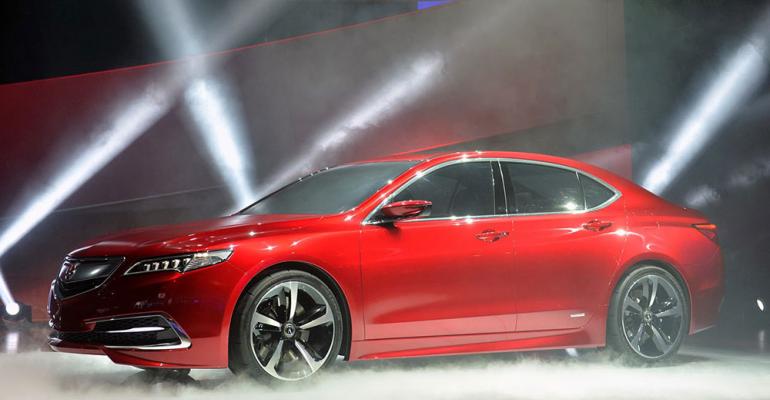CHICAGO – This summer American Honda will launch the first Acura TLX, and it hopes the new car can revive an old trend: high-volume sales for its Acura marque in the middle-large sport sedan segment.
The TLX replaces Acura’s TL and, to a lesser extent, the midsize TSX.
While the outgoing TL has been a so-so performer for the brand with annual sales in the 30,000-unit range, the prior-generation ’04-’07 model sold in higher volumes, with a record 78,218 moved in 2005, WardsAuto data shows.
“We want to get back to that,” Tom Peyton, assistant vice president-Advertising & Marketing for American Honda, tells WardsAuto in an interview here.
Peyton says the upcoming TLX has a personality similar to the “hugely successful” mid-2000s TL.
Peyton acknowledges Acura lately has been more successful in the CUV segment. Last year, MDX sales rose 4.3% and RDX deliveries grew 51.6% from 2012.
Meanwhile, Acura car sales, including those of the RLX flagship sedan and the entry-level ILX, slumped 10.4% in 2013 to 67,285 units.
“We’ve been doing great with MDX and RDX,” he says. “In cars, though, there’s an opportunity to excel even further, and we’ll be betting a lot on (the TLX) to do that.”
Honda announced this week it was installing Americas R&D President Erik Berman to head a new Acura business planning office, reportedly to correct the brand’s car deficiencies.
Masterminding the TLX ad campaign will be Acura’s relatively new ad agency, Mullen.
Peyton classifies the relationship between American Honda and Mullen as “great,” saying the firm has delivered on the new thinking and new style Acura officials want for its consumer messaging.
Mullen crafted Acura’s most recent brand spot, “Let the Race Begin,” which features the TLX Prototype unveiled at January’s North American International Auto Show in Detroit.
The commercial shows robotic horses competing on a track, each bearing subtle hints of the luxury-vehicle brand it represents. The Acura horse darts ahead of the pack, then turns into a real horse, which then transforms into the RLX Sport Hybrid large sedan. The RLX, TLX and upcoming NSX supercar are seen together at the end.
“We made those a little bit of an Easter-egg type of thing, where they aren’t overt competitors, but if you really look closely (at the horses) you can see cues of other competitors’ logos or styling cues,” he says.
While Honda has had a reputation for spending big on manufacturing but short-shrifting advertising, Peyton says that is changing.
He classifies Japan management as “receptive to (American Honda) being a more aggressive marketer,” noting times are different from the 1980s and 1990s when Hondas and Acuras basically sold themselves.
“(Back then) it was the car and the shortage of them and the lust for them that really drove a lot of the (volume, but) we’re a bigger company now,” Peyton says. “We want to do a lot larger volume, and as a result marketing and sales are a bigger piece (of the game plan).”
Like many automakers, Honda is devoting more attention to non-traditional marketing, including social media.
While many industry critics debate social media’s usefulness, Peyton finds the outlet hugely beneficial when it comes to gauging interest in the Honda and Acura brands.
“The thing we like about it is there are 10 different boxes it checks for us,” he says. “A couple million people (can view a) program on YouTube. Then we can see the click-throughs from that to our website to get information. Then there are the Pinterest postings, then there’s Instagram sending of messages to people and the positive comments on what Honda’s doing…and then to some extent you can even say how many did a configuration of the car.”
While it may be difficult to maintain someone’s interest in what could be a half-dozen years between new-vehicle purchases, Peyton sees many people enjoying the notion of being a part of something.
“In the old days, you used to join the Mickey Mouse Club to be part of it,” he says. “People love being part of the Honda club, and social media is a tremendous way to engage them to be part of that club.
“And once you’re part of that club it becomes easier to say, ‘Hey, club members, here’s the new car. Do you have any interest in buying it?’”
Honda has 3.18 million “likes” of its Facebook page, higher than main rival Toyota’s 1.87 million but below Nissan’s 8.82 million.
Honda’s other social-media accounts have smaller followings, with its Twitter page boasting 266,000 followers, its Pinterest account having more than 8,000 followers and its YouTube page 121,609 subscribers as of Feb. 25.





